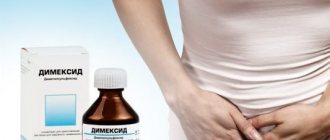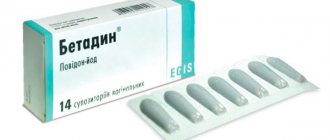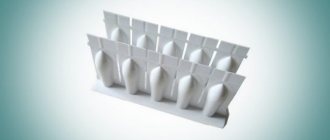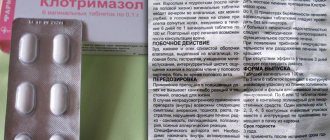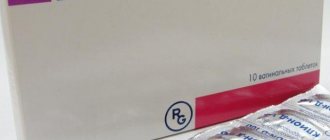Dimethyl sulfoxide (DMSO) is a drug that has local analgesic, anti-inflammatory, antiseptic and fibrinolytic effects.
The following dosage forms of Dimethyl sulfoxide are available:
- 50% solution for external use in plastic or glass bottles of 40, 50, 60, 80, 100, 120 ml;
- 99% concentrate for the preparation of a solution for external use in glass bottles of 50 and 100 ml. Used for self-preparation of a solution of the required concentration;
- gel for external use containing 25% or 50% DMSO, available in aluminum tubes of 30 or 40 g;
- ointment containing 30% or 70% of the active substance, in aluminum tubes of 30 g.
Combination medications containing dimethyl sulfoxide are also available:
- “Propolis DN” and “Propolis D” are rectal and vaginal suppositories, which contain DMSO and propolis. Available in blisters of 6 or 10 suppositories.
- “Dolobene” is a gel containing 15% Dimethyl sulfoxide (in the form of a 10% water-based solution), as well as Heparin and Dexpanthenol. Available in aluminum tubes of 50 and 100 g.
- “Hepatrombin S” is a gel identical in composition to Dolobena. Available in 40 g aluminum tubes.
- "Espol" is an ointment containing 3% DMSO, 2.5% coriander essential oil, 0.25% lavender essential oil, 10% capsicum extract. Available in aluminum tubes of 15, 20, 25, 30, 35 or 40 g.
Medicines containing DMSO are not available
in the following dosage forms: tablets, capsules, powder, syrup and solution for oral administration, ampoules with a solution for intramuscular or intravenous administration, eye drops.
Dimethyl sulfoxide is a drug for external use only. When taking Dimexide orally or by injection, serious consequences are possible, including death!
pharmachologic effect
DMSO blocks substances directly responsible for the development of inflammation - histamine, bradykinins and prostaglandins. The drug penetrates tissue barriers, including skin and joint capsule. In addition, Dimexide increases tissue permeability and dilates blood vessels, facilitating better penetration of other medicinal substances into the site of inflammation and blood flow. This is expressed in analgesic, anti-inflammatory, anti-edematous effects. The drug also has moderate antiseptic and fibrinolytic effects. Increased permeability of the cell wall of some bacteria under the influence of Dimexide contributes to increased sensitivity to antibiotics.
Indications
| Application area | Diseases |
| Rheumatology | Rheumatoid arthritis, ankylosing spondylitis, osteoarthritis deformans, focal scleroderma, discoid lupus erythematosus, erythema nodosum, reactive synovitis, gout |
| Traumatology and orthopedics | Sprains, soft tissue bruises |
| Neurology | Radicular pain syndrome, trigeminal neuralgia, tunnel neuropathies |
| Surgery | Infiltrates, purulent wounds, superficial burns, trophic ulcers, thrombophlebitis, panaritium |
| Urology | Chronic cystitis, acute and chronic prostatitis, urethritis |
| Proctology | Hemorrhoids, proctitis and paraproctitis, anal fissures |
| Dermatology | Pyoderma, furunculosis, acne, eczema, fungal infection of the feet, alopecia |
| Gynecology | Colpitis, adnexitis, endometriosis, candidiasis, cervical erosion, postpartum complications, ovarian cysts |
| Dentistry | Periodontitis, stomatitis |
| Therapy | Laryngitis, pharyngitis, bronchitis, pneumonia |
| Infectious diseases | Erysipelas, inflammation of the parotid gland |
Indications for use in gynecology and other areas
In gynecology, Dimexide is mainly used for:
- cervical erosions;
- postpartum complications (injuries, ruptures, etc.);
- infectious processes in the genital tract;
- endometriosis;
- endometritis;
- postoperative conditions and complications after surgery;
- cystic formations;
- inflammatory diseases of the appendages;
- cervicitis;
- vaginitis (colpitis);
- inflammatory diseases of the external genitalia;
- during the recovery period after radiation therapy for malignant processes of the genital area.
In addition, the product is successfully used in complex treatment:
- various bruises;
- damage to the ligamentous apparatus;
- neuralgia;
- deforming osteoarthritis;
- rheumatoid arthritis;
- infiltrates resulting from trauma;
- radiculitis;
- arthropathy;
- trophic ulcers;
- eczema;
- erysipelas;
- purulent inflammation;
- thrombophlebitis and other pathologies.
Mode of application
A solution for external use and a concentrate for preparing a solution for external use are indicated for injuries (bruises, sprains, contusions), exacerbations of gout, as well as back pain . A compress of Dimexide solution with a concentration of 30-50% is used. To do this, gauze fabric, folded in several layers, is impregnated with a DMSO solution, applied to the diseased area, covered with plastic film and cotton cloth. The duration of the procedure is 30 minutes. 3 applications should be applied per day. For a stronger analgesic effect, you can use a compress with Dimexide (5 parts) and Novocaine solution 2% (3 parts). The duration of this application is 1 hour. Electrophoresis with Dimexide concentration of 5-10% is also prescribed. The duration of the procedure is no more than 5-10 minutes. Number of sessions – from 5 to 10.
For superficial burns, use an aqueous solution in a ratio of 2-3 parts Dimexide to 7-8 parts water. Gauze cloth is soaked in the solution, applied to the affected area and left for 10-15 minutes. There is no need to cover such a compress with plastic wrap. You can do the procedure once a day. Duration of treatment is 3-5 days.
For skin problems (acne, furunculosis and carbunculosis), you should use an aqueous solution in a ratio of 1 part Dimexide to 3 parts water. Gauze, folded in several layers, is applied to problem areas of the skin for 30 minutes.
In gynecology , tampons soaked in DMSO are used. You can use sanitary tampons or make them yourself. To do this, roll a cotton ball with a diameter of 3 cm into a cylinder, wrap it in a piece of bandage 15-20 cm long, secure it with a thread soaked in an antibacterial solution, and form a “tail” necessary for removing the tampon.
Most often in gynecological practice, a DMSO solution is used along with other substances. A solution of Dimexide (diluted in a proportion of 1 part of the active substance to 4 parts of water) in combination with Vishnevsky ointment has strong antibacterial and healing properties. Vishnevsky ointment is applied to a hygienic tampon soaked in a solution of Dimethyl sulfoxide, then inserted deep into the vagina for up to 10 hours. After this, the tampon is removed and replaced with a similar one. The duration of such treatment is 7-10 days.
To prevent the formation of adhesions in the postoperative and postpartum periods, use hygienic tampons with a 20% solution of Dimexide (5 parts), Lidaza (3 parts) and Novocaine (3 parts). A tampon soaked in this mixture is inserted into the vagina for up to 10 hours. Use 1 tampon per day. The duration of treatment is determined individually and averages 7-10 days.
Douching with Dimexide at home is strictly unacceptable! This could result in death from air embolism!
For laryngitis, tracheitis and bronchitis, use an aqueous solution of DMSO at a concentration of 25%. To do this, gauze is soaked in a solution, placed on the chest, excluding the heart area, and covered with cotton cloth. The duration of the procedure is 40 minutes. You should do 1 such application per day. The duration of treatment is no more than 5 days.
When treating sinusitis, there are two methods of using Dimexide:
- Using turunda . First, prepare a solution. To do this, 10 ml of an aqueous 10% solution of Dimethyl sulfoxide is mixed with 10 ml of aloe juice, 10 ml of Chlorophyllipt solution, 1 bottle of Benzylpenicillin. Turunda is soaked in the resulting solution, inserted into the nostril and laid down for 15 minutes. Then repeat the procedure for the other nostril. You can use this method 2 times a day. The duration of treatment is up to 10 days.
- Compress . Gauze, folded in several layers, is moistened in a 20% solution of Dimexide, applied to the area of the maxillary sinuses, and covered with polyethylene and cotton cloth. The duration of the procedure is 1-2 hours. The compress should be used once a day for 10 days.
In dentistry, an aqueous solution of Dimexide is used (2 parts DMSO to 3 parts water). A gauze turunda is moistened in the solution and placed on the affected area for 20 minutes. The frequency of the procedure is 1 time per day, the duration of treatment is 3-6 days.
Gel
To treat superficial burns and acne, as well as lesions of the mucous membranes, Dimexide gel of 25% concentration is used. The drug is applied pointwise in a thin layer to the affected areas, left for 15 minutes, then washed off with water. You need to apply the gel 2-3 times a day. The duration of treatment is 10-15 days.
For bruises, eczema and pyoderma, compresses with a gel containing 50% DMSO are used. To do this, apply a thick layer of the drug to a gauze napkin, apply it to the affected area, cover with polyethylene and cotton cloth, and leave for 25-30 minutes. You can do this compress 2-3 times a day for 7-10 days.
To treat felon, use a gel containing 50% Dimexide. Treatment must begin in the first hours of the development of the disease. A bandage soaked in gel is wrapped around the finger and polyethylene is placed on top. Then fix both layers with a dry bandage. The duration of this compress is 30 minutes. You need to do 3 procedures a day. If there is no effect of treatment on the third day, you should immediately seek surgical help.
When treating hemorrhoids, preference should be given to a combined preparation in the form of a gel containing DMSO, Heparin and Dexpanthenol (“Dolobene” and “Hepatrombin C”). Before using the gel, you must empty your bowels, thoroughly wash and dry the area of application. Apply the gel to the hemorrhoids in a thin layer with light massaging movements. Since this area is difficult to bandage, it is recommended to lie on your stomach for at least 30 minutes after applying the gel. The gel should be used 3-4 times a day.
Varicose veins of the legs . Gel "Dolobene" or "Hepatrombin S" is applied in a thin layer to the area of dilated veins. The product is used at least 4 times a day. The duration of treatment is individual and depends on the severity of varicose veins and concomitant therapy.
Suppositories “Propolis D” and “Propolis DN”
In gynecology, suppositories with Dimexide are prescribed for purulent-inflammatory and fungal diseases of the female genital organs, ovarian cysts, as well as in the postoperative and postpartum periods. Before inserting the suppository, it is necessary to toilet the external genitalia. The suppository should be pushed deep into the vagina. You need to administer 1 suppository in the morning and in the evening. The course of treatment ranges from 10 to 30 days and is determined by the doctor.
To treat urological diseases, you need to use 1 suppository at night, pushing it rectally to the depth of your index finger. The course of treatment is 30 days.
In proctology, suppositories with DMSO are used for hemorrhoids and in the postoperative period. Before using the suppository, you should empty your bowels or do a cleansing enema. Inject 1 suppository 2-3 times a day to the depth of the index finger. The course of treatment is 20-30 days.
CANDLES PROPOLIS D WITH DIMEXIDE
Candles with Propolis and dimexide 10 pcs
Ingredients: cocoa butter, propolis extract 20%, dimexide.
Directions for use: below is complete information on the use of these suppositories for various diseases.
Contraindications: allergic reactions to the constituent components. It is recommended to consult a doctor before use.
USE OF CANDLES WITH PROPOLIS AND DIMEXIDE
in gynecology:
- Colpitis and inflammation;
- Pathogenic fungi, staphylococci and streptococci;
- Leucorrhoea, cervical erosion, cervical dystrophy; metritis, endometritis, parametritis, adnexitis;
- Postoperative inflammatory processes, postpartum complications; inflammation, ruptures, injuries, cracks, discharge; genital thrush (as an additional remedy).
Course: 10-14 days, after the evening toilet and in the morning, intravaginally, 1 suppository; if necessary, the course is repeated.
in proctology:
- Inflammation of hemorrhoids, fissures, ulcers, erosion of the rectal mucosa;
- Acceleration of healing of postoperative wounds;
- Elimination of intestinal spasms, pain relief from paraproctitis.
Course: 10-20 days, following a diet and diet, 1 suppository rectally in the evening (intensive care recommends 2-time use - morning and evening). Treatment of proctological problems requires adherence to a special diet, which should be discussed in more detail with your doctor.
in urology:
- Prostatitis in acute and chronic forms;
- Benign prostatic hypertrophy:
- Chronic cystitis.
Course: 2-3 courses of 30 days are prescribed with 1-2 month intervals between courses, 1 suppository at night after 10 - 15 minutes of a warm bath, rectally.
Dimexide - also known as dimethyl sulfoxide - is a drug used in medical practice as an anti-inflammatory and analgesic agent. Very often, dimexide becomes an indispensable remedy for inflammatory diseases.
Propolis D suppositories are prescribed as both the main treatment and an auxiliary. However, thanks to it, after the first use, pain, spasms and swelling disappear, allowing you to forget a little about the disease.
COMPONENTS OF PROPOLIS D SUPPLIES AND THEIR EFFECTS ON THE BODY
Propolis D candles contain only three components: propolis itself, dimexide (hence the prefix “D”) and cocoa butter. The first two components have similar actions on some points, but in a duet they become more effective, complementing each other.
Cocoa butter has an auxiliary, but no less important, function; it is thanks to it that the candle melts when the temperature rises, and the active substances are perfectly absorbed into the mucous membranes and the systemic circulation.
The similarity of the actions of dimexide and propolis is as follows:
- both components strengthen the body's protective properties;
- both actively resist germs and bacteria;
- both propolis and dimexide effectively relieve inflammatory processes;
- both have analgesic properties.
Restoring damaged cells, resolving scars and preventing tissue thickening is the task of propolis. Propolis is also aimed at suppressing bacterial activity.
Dimexide itself is able to easily and quickly penetrate cells, taking with it other active substances. At the same time, it enhances the effect of “friendly” components; dimexide is often prescribed before taking stronger analgesics to improve the body’s perception of them. It stimulates infectious agents to become hypersensitive to the antimicrobial effect of propolis.
The combination of components in Propolis D suppositories is approved by doctors in the field of gynecology, proctology and urology.
What is most important is that candles relieve inflammation, and this is the first step towards recovery, because a person’s well-being immediately becomes much more cheerful.
For hemorrhoids, suppositories are a real panacea, especially in the first stages of the disease; they can relieve the disease without additional medications.
Propolis D suppositories can be used by anyone who does not have an allergic reaction to bee products.
The product has a good anesthetic effect and is easily administered after taking a warm bath.
INSTRUCTIONS FOR USE OF PROPOLIS D SUPPORTS
Suppositories are effective after surgery in the pelvic area, so they are often prescribed for purchase during the period of postoperative rehabilitation. But candles have found their application in every branch of medicine.
In gynecology. Suppositories as such are always highlighted in gynecology as the most effective remedy, especially in the treatment of the appendages and ovaries. They can be prescribed even to girls who have not yet had sexual relations; the suppositories are completely safe.
At a mild stage of the inflammatory process, only Propolis D suppositories can be used, and severe inflammation requires suppositories with propolis as a drug that has an additional and auxiliary effect.
In gynecology, these suppositories are an active assistant for:
- inflammation of the external genitalia;
- diseases of the vagina and cervix caused by infection;
- fibroids;
- thrush;
- postpartum complications;
- formation of adhesions in the pelvis;
- cervical erosion.
Propolis D suppositories kill pathogenic microbes, relieving inflammation, accelerating the process of healing and tissue restoration. They relieve a woman from the discomforting symptoms of the disease: itching, redness, swelling, burning. After recovery, the suppository is able to restore the vaginal microflora to the “normal” level, eliminating bacterial vaginosis and candidiasis.
Suppositories are administered both vaginally and rectally.
In gynecology, both methods are used for various diseases.
If the treatment is aimed at the body, cervix or vagina directly, then the suppository must be inserted into the vagina.
Important! Before introducing suppositories, it is useful to do herbal douching; just buy a package of chamomile, calendula, St. John's wort or celandine at the pharmacy and brew it according to the instructions. The price of herbs is not high, and the effectiveness of treatment will immediately become higher.
It is recommended to administer Propolis D suppositories rectally during therapeutic sessions for adnexitis, salpingitis, in the presence of adhesions in the pelvis and other diseases.
The average treatment period is two weeks, during which 24 suppositories are used (administered twice a day). Detailed instructions and duration of the course should be checked with your doctor.
Field of urology. Particularly insidious are urological diseases that do not appear immediately. The source of the disease flares up gradually, completely unnoticed by a person, and the stronger the immune system, the longer the body will fight without showing any symptoms. Gradual swelling of tissues leads to pain when urinating and disruption of this process.
Important! The main danger of urological diseases is the growth of scar tissue that affects organs.
Propolis D suppositories begin their action by relieving swelling, after which pain when visiting the toilet and inflammation itself disappear.
The advantage of the suppository is that propolis prevents the growth of scar tissue, protecting internal organs.
The drug received positive reviews in the fight against the following diseases:
- prostatitis at all stages of manifestation;
- hypertrophy;
- cystitis.
Brief instructions: suppositories are administered rectally after taking a 15-minute bath. The procedure is carried out at night every day for only 1.5 weeks. The course must be repeated twice more after two months.
In proctology. Hemorrhoids are the most delicate and problematic disease. In order not to bring it to the operating table, doctors prescribe Propolis D suppositories. They gently heal cracks and wounds in a place saturated with nerve endings, primarily relieving pain and itching.
Also, suppositories with Propolis and Dimexide are effective for:
- ulcers and erosions of the rectal mucosa;
- intestinal spasms;
- paraproctitis;
- postoperative period.
Attention! Suppositories for hemorrhoids should be used only in combination with the correct diet, which is prescribed by a doctor.
Generalized instructions for the treatment of hemorrhoids and other diseases in the field of proctology: from 1.5 to 3 weeks of daily use of the Propolis D suppository in the late evening. With enhanced therapy, suppositories are administered twice a day.
ADVANTAGES OF CANDLES FOR TREATMENT
The popularity of suppositories as a medicinal drug is growing, people prefer their convenience and effectiveness in the fight against diseases of various stages, combined with the price, others listen to these reviews and want to buy the drug. A logical question arises: why are they better?
THE MOST SIGNIFICANT ARGUMENTS for choosing suppositories for hemorrhoids or other diseases:
1. suppositories are placed directly in the place that requires treatment, which means that all 100% of the active ingredients will be used for a speedy recovery;
2. no discomfort during treatment. Intravenous administration of antibiotics is unpleasant in itself, and afterwards leaves bumps and bruises; vaginal tablets used in gynecology injure the mucous membrane and require additional preparation before administration; ointments spread greatly when heated. But suppositories are a soft preparation that is administered almost painlessly, they quickly melt from body temperature and are evenly distributed inside;
3. the small number of components reduces the possibility of allergic reactions during the course;
4. the components of the candles act gently, instantly relieving the most acute discomfort;
5. The effectiveness also lies in the fact that bacteria beneficial to the body are not affected by the active components of the drug, but pathogenic cells are removed from the body;
6. You can easily buy them at the pharmacy, or you can make them at home yourself, because all the ingredients are available for sale;
7. The price of a ready-made suppository is minimal compared to antibiotics and medications that restore the body’s microflora after them.
Release form: suppositories from light yellow to light brown, 10 suppositories in one package.
Storage conditions: store candles in a dry, dark place at a temperature not exceeding 10°C.
Shelf life: 2 years.
Contraindications
The drug should not be used if:
- diseases of the cardiovascular system: severe heart failure, myocardial infarction, angina pectoris, severe vascular atherosclerosis;
- pathologies of the nervous system: coma, stroke (regardless of type);
- ophthalmological pathology: cataracts and glaucoma;
- kidney and liver diseases;
- allergies to Dimexide or other components of the drug;
- An additional contraindication to the drugs “Dolobene” and “Hepatrombin S” is the tendency to bleed.
Interaction and compatibility with other drugs
DMSO enhances the absorption of certain substances (lidocaine, novocaine, NSAIDs, antibiotics, phenylbutazone, nitroglycerin, digoxin), which leads to an increase in their effects, and in some cases to increased toxicity.
With long-term simultaneous use of dimethyl sulfoxide and insulin, the dose of the latter should be gradually reduced.
The drug increases the body's sensitivity to anesthesia.
Dimexide enhances the absorption of alcohol. Ethyl alcohol, in turn, inhibits the removal of DMSO from the body. Therefore, it is strongly recommended not to drink alcohol while using medications containing dimethyl sulfoxide.
special instructions
Pregnancy and lactation.
The drug is contraindicated in pregnant women and nursing mothers. There have been no studies confirming or refuting the negative effects of Dimexide on the body of the fetus or pregnant woman. However, animal testing has shown adverse effects on the fetus. Thus, the potential risk of using the drug significantly outweighs the positive effects. DMSO can pass into breast milk and is therefore contraindicated during breastfeeding.
Childhood.
The age of a child under 12 years is a contraindication to the use of Dimexide. Despite this, many consumers use the drug in children of different ages, including infants. But parents must understand that the child’s skin, excretory, endocrine, and circulatory systems have a number of features that can affect the penetration of the drug into the blood, its distribution in the body and excretion in the urine and exhaled air. It should be noted that the combination drug Dolobene, containing 15% DMSO, is approved for use in children over 5 years of age.
Contraindications and possible side effects
The use of Dimexide may be accompanied by some side effects, which disappear after discontinuation of the drug. The drug also has a number of contraindications for use.
Dimexide is prohibited for use when:
- pregnancy;
- during breastfeeding;
- renal or liver failure;
- severe damage to the organs of vision (glaucoma, cataracts, etc.);
- strokes;
- pathologies accompanied by the development of comatose states;
- cardiovascular diseases (including a history);
- intolerance to the active and auxiliary components of the drug;
- under the age of twelve and after sixty years.
The use of Dimexide during pregnancy and breastfeeding is strictly contraindicated
The use of Dimexide during pregnancy and lactation is strictly prohibited, as this can cause miscarriage or premature birth. In addition, the drug is excreted in milk, which can negatively affect the baby’s health. Therefore, during its use and for two to three days after the end of the course of therapy with this drug, the child should be fed with an artificial formula.
Dimexide can cause some side effects that go away when it is discontinued. These include:
- various allergic reactions;
- dry skin;
- burning sensation upon contact with the product;
- contact dermatitis;
- rashes on the integument of an erythematous form;
- intolerance to the smell of the drug with developing nausea and vomiting;
- a garlic odor may appear in the exhaled air.
It is necessary to take into account that Dimexide can enhance the therapeutic and toxic effects on the body of other drugs used simultaneously with it. Therefore, you should definitely consult your gynecologist before use, and also be careful when using this drug.
Prices
Prices for drugs containing DMSO vary significantly depending on the form of release, manufacturer, and region of sale.
- A solution for external use (“Dimexid”, “Dimexid-FT”, “Dimexid-ZhFF”, “Dimexid-RNP”), depending on the volume of the bottle, costs from 32 to 80 rubles.
- A concentrate for preparing a solution for external use (“Dimexide”, “Dimexide-Lugal”) costs from 47 to 85 rubles.
- Gel for external use costs from 137 to 237 rubles.
- The ointment will cost from 102 to 120 rubles.
- Suppositories “Propolis D” and “Propolis DN” cost from 340 to 554 rubles.
- Gel "Dolobene" costs from 260 to 605 rubles.
- Gel "Hepatrombin S" costs from 184 to 330 rubles.
- Espol ointment costs from 240 to 390 rubles.
Methods of using the product and instructions for them
The concentrate in its pure form is never used, as it can cause burns to the mucous membranes and skin. It must be diluted with water for injection, or with plain boiled water (this dilution is used at home). The required concentration for each disease is determined by the attending physician.
Various compresses, applications, and vaginal tampons are made with Dimexide.
Dimexide is used externally and intravaginally
When administering the drug intravaginally, it is best to use homemade tampons; it is not recommended to use store-bought ones, since they consist of synthetic materials and are often impregnated with special substances that retain moisture. Self-production, as a rule, does not cause difficulties for patients. All you need for this is sterile cotton wool and a bandage. The finished tampon is well impregnated with the drug of the required concentration, lightly wrung out and inserted into the vagina as deeply as possible. In addition, other medicinal drugs can be added to Dimexide, for example, painkillers or antibiotics. It promotes their rapid penetration and impact on areas of inflammation and infection. Such tampons are placed in the morning and evening, and on average treatment lasts up to ten days.
Application of compresses and applications is mainly used for lesions of the external genitalia (vulva area, labia majora and minora, vaginal vestibule, perianal area). It is also advisable to use sterile cotton wool and bandages. They are well soaked in the solution or generously lubricated with gel for external use and applied to the affected area for a certain time. This method is used in the same way as tampons, twice a day.
In addition to this effect, Dimexide is also used during physiotherapy. The most commonly used procedure in gynecological practice using Dimexide is electrophoresis. With its help, the drug can penetrate through the skin into organs that need treatment. Thanks to this effect, inflammation is relieved and pain is eliminated. This is how infectious and inflammatory diseases of the fallopian tubes and ovaries are treated.
Before you start using the drug for its intended purpose, you should conduct a small sensitive test to determine the possibility of its further use. It is necessary to apply a small amount of solution or gel to the inner surface of the elbow. If within half an hour there are no changes in the skin (redness, itching, burning, etc.), then the product can be used. Otherwise, the product is contraindicated.
Analogs
There are no drugs available that are chemically similar to Dimexide. Analogs of the drug are selected individually, based on goals and contraindications.
In the treatment of acne, pyoderma and other inflammatory skin diseases, the following is used: an alcohol solution of Salicylic acid (1%, 2%), liniment Sintomycin, liniment Streptocide, Levomycetin ointment (or the combined drug Levomekol, which also contains Methyluracil - a tissue regeneration stimulator), zinc paste.
In the treatment of bruises, sprains, hematomas (bruises), back and joint pain, ointments and gels containing NSAIDs are used: Diclofenac, Voltaren, Dicloran, Ketoprofen, Ketonal, Flexen, Fastum Gel, " Bystrumgel."
In the treatment of hemorrhoids, “Hepatrombin G”, “Relief”, “Proctosedyl”, “Proctoglivenol” suppositories are used, as well as “Aurobin” and heparin ointments.
In the treatment of vulvovaginitis, adnexitis, and also after operations, tampons soaked in Levomekol ointment can be used. They are used at night, the course of treatment is 8-14 days. To normalize blood flow in the pelvic organs, tampons impregnated with Troxevasin are used. It is recommended to use 1 tampon at night, the treatment period is 14-21 days.
In folk medicine, there is a method of treating vaginal dysbiosis with garlic tampons. However, given the strong irritant effect of garlic and the sensitivity of the mucous membrane of the female genital tract, the use of this remedy is strongly not recommended.
Reviews
According to the portals Irecommend.ru and Otzovik.com, more than 90% of users left positive reviews about the drug Dimesid. Consumers note low cost, good tolerability, high efficiency, wide range of applications and many forms of release. Among the disadvantages, the most often noted are an unpleasant odor, the presence of contraindications, and a burning sensation when using high-concentration solutions.
Read
Also:
- Hemostatic drugs in gynecology
- Features of the use of Metrogyl (plus) gel in gynecology
- Clotrimazole: indications, method of application of antifungal ointment
- Diclofenac suppositories - use in gynecology for inflammation
- The use of Galavit suppositories in gynecology
- Vishnevsky ointment - application in gynecology, how to make a tampon


